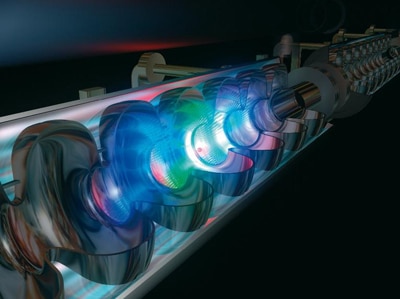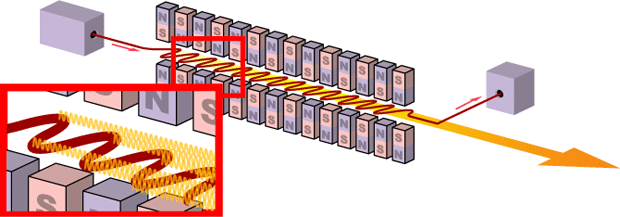
I follow a lot of medical technology blogs, and for every one med blog I read, I read three National Defense blogs. Why? Mostly because there is so much more going on with lasers and high energy light sources in killing people and things than there is with killing cancer and other undesirables. For example…
The Department of Defense is giving Boeing and a company called Raytheon about $6,900,000 and change to develop something called a free-electron laser. The free-electron laser, or FEL, uses electrons that move around the speed of light (relativistic particles) to generate a high speed beam. From DefenseLink:
Raytheon Co., Integrated Defense Systems, Tewksbury, Mass., is being awarded a $6,928,056 Task Order 0001 Phase 1A under a cost plus fixed fee, indefinite delivery indefinite quantity order contract for the preliminary design of a 100-kw class Free Electron Laser (FEL) device which can be used to demonstrate scalability of the necessary FEL physics and engineering for an eventual MW class Free Electron Laser device. The Office of Naval Research is the contracting activity (N00014-09-D-0353).
The Boeing Co.,. Directed Energy Systems, West Hills, Calif., is being awarded a $6,922,312 Task Order 0001 Phase 1A under a cost plus fixed fee, indefinite delivery indefinite, quantity order contract for the preliminary design of a 100-kw Class Free Electron Laser device which can be used to demonstrate scalability of the necessary FEL physics and engineering for an eventual MW class Free Electron Laser device. The Office of Naval Research is the contracting activity (N00014-09-D-0354).
What?
Okay, real quick – relativistic means essentially “kinda like the speed of light,” or near the speed of light. These FELs use a series of magnets with reversed poles to get that beam moving. When you were a kid, did you ever do that experiment where you had a bar magnet on a turntable-type device, and used another bar magnet to propel the turntable in a circle by putting like poles to like poles, this repeling the magnet on the turntable? Well, it’s kinda like that, but not really anything like that at all. But now you have a frame of reference – and now I sit here cracking myself up at my paragraph-long description.
This free-electron laser is miraculous for several reasons:
- It never runs out of shots
- It doesn’t use crystals, chemicals, or other nasty stuff to excite the electrons in its beam
- It’s relatively impervious to atmospheric changes
- It’s got a alternating magnetic field generator is called a Wiggler
and other reasons involving complex mathematics. One of the coolest things about the free-electron laser is the fact that atmospheric conditions like storms, thunder, humidity, etc. The FEL can sort-of regulate and recalibrate itself to slice through different kinds of air and conditions – perfect for sea-based weapons. Due to this pretty interesting and amazing trait, it’s considered perfect for putting on ships to combat missiles, planes, and other stuff made for destroying ships. The FEL laser would be about 7-8 times more powerful than other lasers in that class, and reaching weapons-grade, or 100 kilowatts.

But back to the original point – FELs are being developed by Boeing and Raytheon to replace the Phalanx CIWS (close-in weapons system) on Navy ships. Since the FEL laser would have “unlimited ammunition,” per se, it seems as though it’s a perfect replacement for the Phalanx system. Oh yeah, what’s the Phalanx system, right? Well, it’s a rapid-fire 20mm gun system with seeking and searching radar that looks for stuff that will possibly kill the ship, and it kills it. Like this – watch how quickly this thing moves and fires:
Funny enough, the same company that makes the Phalanx is Raytheon. We’ll see how this FEL laser system goes – I keep hoping that somehow this military technology will spawn some medical technology and help rid the world of stuff inside us that wipes us out.
Thanks, Danger Room!





Comments are closed.